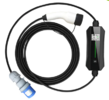I'm getting conflicting information on installation of an EV charger.
Some electricians require direct connection to tails through connection blocks and a separate, £150 JB while others state that it can be wired directly to the consumer unit on a 32A MCB (CU is 100A with spare MCBs).
Ohme doesn't require an earthing rod so I think that the JB might be an overkill, but wanted to ask for your opinion.
Also tails between the 100A fuse and a new smart meter installed in 2020 look like 16mm² (no markings but are thinner than 25mm) while those going to the CU are the correct, 25mm².
Most electricians told me it's correct as those are only 30cm long, they obviously don't not swap them anyway and they are hesitant to ask DNO due to lead times it takes them.
Shouldn't the meter installer upgrade those to 25mm² as a "new connection" and are those sufficient for a 100A fuse?
Some electricians require direct connection to tails through connection blocks and a separate, £150 JB while others state that it can be wired directly to the consumer unit on a 32A MCB (CU is 100A with spare MCBs).
Ohme doesn't require an earthing rod so I think that the JB might be an overkill, but wanted to ask for your opinion.
Also tails between the 100A fuse and a new smart meter installed in 2020 look like 16mm² (no markings but are thinner than 25mm) while those going to the CU are the correct, 25mm².
Most electricians told me it's correct as those are only 30cm long, they obviously don't not swap them anyway and they are hesitant to ask DNO due to lead times it takes them.
Shouldn't the meter installer upgrade those to 25mm² as a "new connection" and are those sufficient for a 100A fuse?


